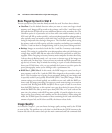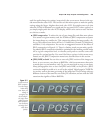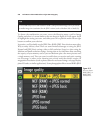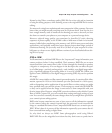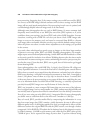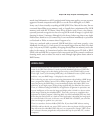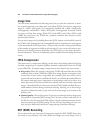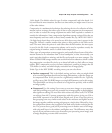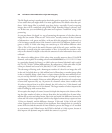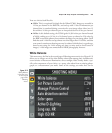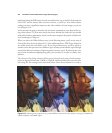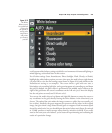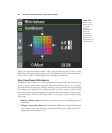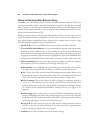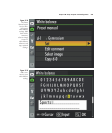The Bit Depth setting is another option that looks good on paper but, in the real world,
is less useful than you might think. For most applications, the default value that pro-
duces 14-bit image files is probably your best choice, especially if you’re exposing
images that will be combined using HDR (High Dynamic Range) software later
on. In that case, you can definitely gain some extra exposure “headroom” using 14-bit
processing.
As you may know, bit depth is a way of measuring the amount of color data that an
image file can contain. What we call “24-bit color” actually consists of three channels
of information—red, green, and blue—with one 8-bit bit assigned to each channel, so
a 24-bit image contains three 8-bit channels (each with 256 different shades of red,
green, or blue). A 24-bit color image can contain up to 16.8 million different colors
(256 × 256 × 256; you do the math). Because each of the red, green, and blue chan-
nels always is stored using the same number of bits, it’s become the custom to refer
only to the channel bit depth to describe the amount of color information that can be
collected.
So, when we’re talking about 12-bit color, what we really mean are three 12-bit RGB
channels, each capable of recording colors from 000000000000 to 111111111111 hues
in a particular channel (in binary), or 4,096 colors per channel (decimal) and a total of
68,719,476,736 (68.7 billion) different hues. By comparison, 14-bit color offers 16,384
colors per channel and a total of 4,398,046,511,104 (4.4 trillion) colors.
The advantage of having such a humongous number of colors for an image that will,
in the end, be boiled down to 16.8 million hues in Photoshop or another image editor
is that, to simplify things a little, there is a better chance that the mere millions of col-
ors you end up with have a better chance of being the right colors to accurately repre-
sent the image. For example, if there are subtle differences in the colors of a certain range
of tones that represent only, say, 10 percent of a channel’s colors, there would be only
26 colors to choose from in an 8-bit channel, but 410 colors in a 12-bit channel, and
a whopping 1,638 colors in a 14-bit channel. The larger number of colors improves the
odds of ending up with accurate hues.
It’s not quite that simple, of course, because bit depth also improves the chances of hav-
ing the right number of colors to choose from after the inevitable loss of some infor-
mation due to noise and other factors. But in the real world, the difference between 26
colors and 410 colors is significant (which is why digital cameras always capture at least
12 bits per channel), and the difference between 12 bits and 14 bits (410 and 1,638
colors, respectively in our example) is less significant. Even though there is a penalty in
terms of file size and the amount of time needed to process the image as it is recorded
to your memory card, Nikon has set the D7000 to default to 14-bit capture, because it
does improve the dynamic range for which the camera is so prized.
David Busch’s Nikon D7000 Guide to Digital SLR Photography242



